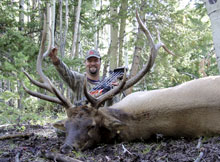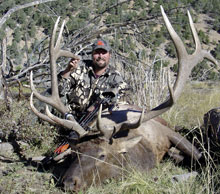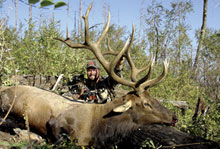October 28, 2010
By Joe Byers
What Hunter Would Dare To Dream Of Three Great Bulls In The Same Season?
By Joe Byers
 Dan Evans spent eight days scouting and 21 days hunting to take this 312-inch elk at 12 yards early in the 2003 season, before hurrying off to another state where he held a draw tag. |
Some of the people who manufacture archery products also happen to hunt. Dan Evans is an elk hunter who happens to manufacture archery products. He's one of those guys who's dyed in the wool, hard-core about his hunting. He uses all the elements of research, tag drawing, scouting and dedicated hunting time to put himself in position to shoot big bull elk. He's among those few remarkable guys who does it all on public land, without a guide. In 2003, Dan's remarkable season included three trophy bulls from three separate hunts. Even for guys who don't put as much time in, Dan's story has something to teach about pursuing big bull elk.
"I had two days left in that hunt," Dan recalled as he layed out the details of his third monster bull in five days. "My brother and I showed up after dark on September 18 and began scouting. We immediately split up and went out to listen and locate bulls bugling in the dark. The next morning we drove a few miles from camp and hiked into where bulls had been bugling. We heard two right away, but both sounded like immature animals, yet I've learned over the years that you can't always tell the size of a bull by its bugle. I snuck into 30 yards of a five-point in an old burn. We could hear the other one 200 yards away, coming toward us. I was very relaxed, expecting another rag-horn to appear, when all of a sudden, a huge rack appeared on the horizon. This bull had a seven-by-eight frame with matching 18-inch sticker tines on each side. The bull stopped broadside at 19 yards with one little hole in the brush. I released and the animal went 35 yards and crashed."
Advertisement
This monster bull was the third of the season for Evans and joined a long line of standout trophies. Evans' office looks like an elk museum, yet he does it on his own, and even buys a good share of his licenses for different states over the counter.
Evans is secretive about his hunting locations. "A lot of people follow me around, trying to find my spots," he says with a sly grin. "I do a lot of scouting and research to find big bulls, something anyone can do."
Advertisement
THE SEASON BEGINS
Evans left home on August 12, with his brother John, wife and two children. "I began hunting on the 20 of August, begins Evans. We traveled in a camping trailer and the kids played during the day until I came back each night. Sometimes I spiked out, but mostly I came home. My brother lived in a tent and operated a video camera for scouting purposes and to catch the hunts on tape. We split up each day, used good optics, and spent much of the preseason glassing.
"Each night we came back to camp and talked about what we'd seen. Watching an animal on video tape gave us a greater opportunity to score the antlers. I probably have video of 100 bulls from this past season. I set my standards high, usually 360 or better.
Continued -- click on page link below.
 With only five total days to hunt in a tough-to-draw unit, Evans was able to tag this gross-scoring 370-inch bull after spotting an animal he estimated would score over 400 inches. |
"The second to the last day of the hunt I had a 335-class bull in my sights, but didn't shoot. I knew that I had one more day and have developed the discipline to give a trophy every opportunity. The final day of that season, I shot a bull that scored 312. The shot was close, about 12 yards, and the animal went down quickly. My brother and I spent the next day getting the bull out and then quickly broke camp and headed for the next state.
"I had hunted 21 days straight before taking an animal and I had just five days left in the next state's season. The second hunt had much better trophy potential. There were only 50 tags and a real chance for a 400-inch bull so I passed up quite a lot of antlers. Early in the hunt I saw a bull over 400 inches and spent the rest of the hunt trying to find it. As sometimes is the case, I passed up several bulls that were really big. Getting down to the end of the season, I took one that grossed 370 and nets 360. Still, I'm very happy."
Prior to the season, Evans practices at distances over 100 yards. Despite this long-range practice regimen, he was thrilled to take all three bulls at 12, 19, and 20 yards.
BUGLING AND COW CALLING
"I don't really have a procedure when calling elk," Evans began. "I used to overcall with bugling or cow calls and that's not realistic. To remedy the times when I feel I must call, I do calf sounds and have had this work well for me. If a calf gets lost, it just calls constantly, over and over. It is a higher version of a cow sound, usually shorter. It often gets the cows to say something and then the bulls get started.
"With respect to bugling, I prefer to hear a bull bugle or locate it with a bugle from a distance. Preferable it will bugle on its own. If it does, I get on the down wind side, as close as I possibly can without saying anything. I start with the most low-key call, regular cow sounds and mews. A lot of times, the bull won't say anything or keeps bugling, but not as a response to me. Then I step it up a little bit and have had good luck with more raspy, hyper-hot sounds. I don't go all out, but call a little bit raspy or aggressive. A lot of times that will get that bull going.
"Two years ago a bull was bugling from its bed. I tried soft sounds, then got raspier and the bull would answer, but still not get up. So, I tried to sound like a bull, giving some tending sounds, bugles and raspy cow sounds. That did it. In it came. I have had that scenario happen a number of times.
"I have also killed several bulls after just bugling at them. I have found that if you bugle from a distance they will answer, while from mid-range they will move away. If you bugle when they are really close, they will come fast. I have bugled in thick country at 10 yards where we can't see each other. That's the extreme of course, yet you want to get as close as the terrain will allow. This fall, I hunted in northern Idaho late in September and got within 20 yards of two bulls where I could see them. They weren't big enough."
Continued -- click on page link below.
 Evans was able to arrow this monster bull, his third in the 2003 season, as it walked into range while he monitored a nearby five by five animal. Evans prefers to sneak into the wind close to bugling elk before producing any calls. |
IMITATING ELK
"My idea on sound is like calling. If you make sounds like an elk, it may work. I have hunted with guys who constantly seem to be zipping or pants rubbing or stripping Velcro. I try to wear soft clothing and soft-sole shoes that won't make unnatural sounds. I pull grass with my hands to sound like elk eating and use a dead stick to simulate a bull raking. The basic rule for sound is to make none that are foreign to the area. Antlers hit bushes and hooves thump logs all the time -- natural sounds in the elk woods. If you don't know what else to do, mimic the sounds you hear. If he rakes, you rake. If he bugles and doesn't chuckle, you do the same. I rarely use a chuckle. I do the high part of the bugle and stop off at the end. Just the high notes work for me.
"I think you should adapt to the sound of the bull. If you are hunting herd bulls, the size of the bugle doesn't matter. That's the bull I'm usually after. If he thinks he is the biggest bull around he won't be intimidated. If you are hunting satellite bulls, you definitely don't want to sound too big because these animals are used to getting their butts kicked. It's better to sound smaller."
CALLING ELK
"I have used about every caller out there. My favorites are from Primos and Glen Barry at Barry Game Calls. I also use Carlton, Sceery and Woods Wise. Most of them have calls that work well. Right now, I use the first two.
"If you are a beginner, I recommend the blow-through call because you get a good sound. However, it's necessary to learn to use a diaphragm. It's easy for turkey hunters; in fact you can use the same caller. Diaphragms are so important because your hands are free. Almost every bull I shoot I have to stop with a call. If you don't have the call in your mouth you are running a risk. With a blow through call, your hands aren't free to draw the bow."
CRITICAL ELEMENT OF SUCCESS
"My trophy standard is a 300-class bull elk or better. There are a lot of states that have good elk hunting over the counter. If you haven't hunted a lot, don't set your sights too high. If you can go out west to any state where you can get a tag (reasonably easy) don't expect to find bulls of the 350-class. Find an antler size to be happy with. If you have not taken a bull, take the first opportunity, even if it's a cow and don't get your hopes too high. You will enjoy your hunt a lot more if you are realistic.
"I'm self guided but I hunt elk a lot. It really comes down to time. If you only have a week, go with a good outfitter. Talk to your friends or call Fish and Game to get lists of guides and check on references. Especially talk to the ones that didn't kill. Success rates aren't very high for archery elk -- on average not more than 15-percent. If you hunt for 10 years you will only kill a couple of elk. With a good outfitter the odds are way higher.
"If you do have the time, hunting on your own is a great way to go. Take a minimum of 10 days hunting time. If I draw an area, I scout for several days before I hunt. If you can't get there before the season opens, plan your whole hunt during the season so that you can scout and hunt at the same time. Do as much research as you can. Get good topographical maps as well as forest service maps that show all of the forest service roads. Study them. I use a GPS and recommend it highly. Team the GPS with maps and you will be amazed how you can navigate."
Continued -- click on page link below.
HOW TO DRAW TAGS
"Idaho, Utah, and Oregon have tags you can get every year. Idaho is a quota system but they usually don't sell out. Other states as well have over-the-counter tags. Also, there are a lot of drawing states that are not that hard to draw. Go to wildlife agency websites. A lot of states don't send out regulations since most hunters have Internet access. Subscribe to an information agency. Garth Carter hunter services is a prime example (www.huntinfool.com). More than anything, he reminds me when to put in for a hunt.
"If you want to hunt elk often, don't put in for the top hunts. Even with bonus points, because you probably won't draw. There are lots of good hunts out there with good drawing odds. Some units have draw odds up to 90-percent where the best hunts are less than five-percent. Probably about three quarter of the bulls I shot were on over-the-counter licenses. I have been putting in for a long time and finally have drawn a couple of primo tags."
TACTICS THROUGH THE SEASONS
"How you hunt depends on the time of the year and the stage of the rut. I consider anything before September 5 to be early season. Bulls aren't bugling actively. I like to glass and do a lot of it. One of the best authorities is Randy Ulmer. Before I knew him, I read his articles. He has some great ideas on that subject. Also, buy the best optics you can afford; they get better with price. About three brands are tops and any one of them is good.
"I glass early and late and explore the country in the middle of the day to check out water. But, during prime time, I try to be glassing areas you can see. If visibility is limited, sit on water holes. Elk will still be drinking and starting to wallow.
"Bugling activity picks up around the end of the first week of September, increases through the third week and peaks around September 20 to 22. After that, bugling tapers off late into the month. In late season, my ideal tactic is to hear a bull bugle and then sneak in on him without making a sound. The really big bulls are almost un-callable and the more you sneak, the better the chances for a really trophy bull.
"Finally, after the peak of the rut, the bulls are still following the herd, but won't want to leave the cows. It's tough to call them away so I try to get ahead of them. This can take a lot of time and can cause scent problems because herds often move into the wind. Sometimes, you can get a bull to go a little out of his way and into range with cow calls."
Dan Evans has a passion for elk hunting and embraces each day afield. His quest for and success with giant antlers is an indication of the great potential the west has to offer. Embrace his techniques and you can afford a fantastic hunting and camping adventure each fall.
Editor's Note: Dan Evans operates Trophy Taker, maker of archery rests and sights. For more information about him, check his website at www.trophytaker.com.
